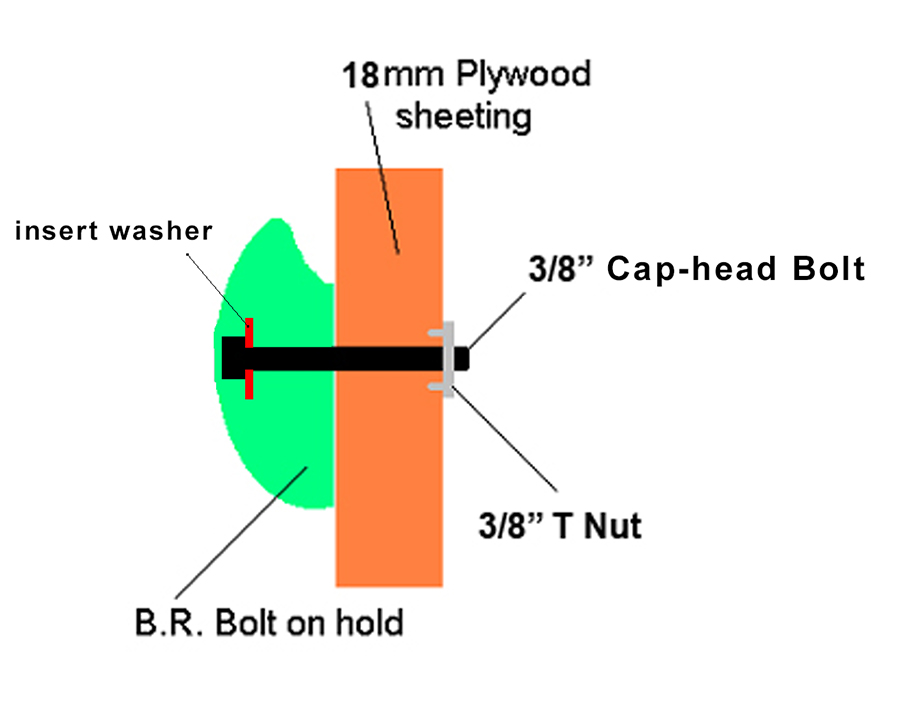Climbing Hold Colours
A large range of colours are available, If you require specific colours please call us to discuss.
All holds otherwise will be random.
How many holds do I need?
Well this depends on hold size and application. For starting out on a vertical wall you can get away with 5 holds per square meter.
However as the wall gets more inclined or you have small children more holds are generally needed because you are restricted by arms reach. For a adults home training board I would recommend 10 to 15 per square meter.
To calculate how many holds you need first work out the square meter of the wall and then times it by 5 (minimum)
So for a home wall around 3m x 2.4m we would recommend around 36 holds.
Fixings
There are two types of bolts that are used for fixing climbing holds to the wall. They are Cap Head and countersunk.
Bolts are either black steel or Stainless steel. For indoor walls use black bolts and for out door use Stainless Steel.
Bolt Diameter
In Australia we tend to use 3/8" diameter. But on some walls you may see M10.
Bolt length
Bolts range from 1.5" to 4" (38mm to 100mm) long. Bolt length is determined by the thickness of the hold. Correct bolt selection is essential.
Important: Bolts must be long enough to pass through the climbing hold, panel and T-nut. See diagram below.

Screw on holds
Generally most climbing holds are bolted onto the climbing surface with bolts and a threaded t-nut that is inserted into the back of the plywood panel.
But some times there are places where traditional bolt-on holds cannot be placed.
This is where screw on holds come into their own. They are simply attached with wood screws. The minimum standard for the wood screws is Type 17 10gauge.
The screw length is determined by hold thickness and plywood thickness (plywood needs to be a minimum of 18mm thick)
If you are using an electric drill set it to a very low torque setting, this way you will not drive the wood screw into the hold and damage it.
Caution:If using an electric drill use eye protection to protect your eyes.
Where can screw on holds be placed?
- Aretes
- Kick boards
- Tight inside and outside corners
- Head walls
Advantages of screw-on holds?
- They don’t require t-nuts or bolts
- They can generally go any where on the climbing wall
to view the screw on holds click here
T-Nuts
T-nuts are basically a threaded nut with a series of prongs on the flanged side of the nut. These prongs once driven into the rear of the plywood panel help to prevent the t-nut from spinning and allow for attaching the holds with the bolts.
The great advantage of the t-nut once that it has been inserted is that you can place the climbing holds from the front of the wall with out having to go around to the back.
T-nuts are available in two types of material. These are steel and Stainless steel.
Depending on the application select the appropriate type.
To insert the t-nut first drill a 12mm hole in the required location in the plywood panel. Then bang in the t-nut into the rear of the side of the climbing wall surface (18mm plywood panel) with a hammer.
If using screw on t-nuts place the screws around the circumference of the flange of the t-nut. Again the flange side of the t-nut is on the rear side of the climbing wall surface (18mm plywood panel).
TIP: Try to make sure you place the t-nuts square to the panel.
Steel / Zinc coated type
- will rust and corrode if exposed to rain or very humid conditions
- cheapest option
- Good for walls that are not exposed to the elements (indoor use)
Stainless Steel type
- Excellent corrosion resistance
- Suitable for both indoor and outdoor applications
- More expensive than regular steel or zinc plated t-nuts
